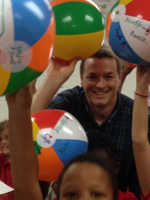Authentic Assessment Through the Art of Collaborative Video Production
,
Colorado Convention Center, Mile High Ballroom 1BCD
Presenters


Session description
Purpose & objective
The primary purpose of this session is to introduce participants to a process we call Collaborative Video Production (CVP). During the initial part of the session, we will discuss relevant research supporting collaborative work, video production in general, and CVP specifically. We will introduce the 7 steps of CVP and provide information on each step. This will help us meet our first objective which is for the participants to learn the background of CVP and the 7 steps of the process.
The secondary purpose is to provide an opportunity for the participants to go through the CVP process as learners in a hands-on, meaningfully engaging, collaborative experience. By experiencing and participating in the activities we have developed for this session, our participants will learn how to design, develop, and conduct a CVP activity. They will also have the opportunity to reflect on their experience at the end of the session and share their insight with other participants.
By the end of this session our participants will be able to:
Discuss the background of CVP and the it’s benefits to student learning
Design a CVP activity integrating the 7 steps of the process
Develop a general plan for incorporating a CVP activity into their classroom
Conduct a CVP activity with their students
Reflect on their experience of going through the CVP process during the session and share insight with others
Outline
15 minutes:
The initial content being presented will be questioning why incorporating video production activities into the classroom might be beneficial. We will look at some of the research behind collaborative work, video production in general, and then introduce the process we call collaborative video production (CVP). CVP is a multi-step, collaborative activity that allows students to demonstrate their understanding through the medium of video.
20 minutes
After the steps have been introduced and discussed, the participants will be divided into groups and will take part in hands-on activities that will require collaboration and teamwork. The purpose of these activities are multifaceted. Since the activities are designed for students, the primary purpose for doing it with the participants is to model it for them. The second purpose is to provide the participants with an authentic learning experience, so rather than describing the activities to them, we let them go through the process themselves. This makes it easier for teachers to envision how it might look in their own classrooms. The first activity will involve taking a story that is told in 8 panels (like a comic strip) and arranging it in an order that is agreed upon by the group. After another round of decision making, the final products are hung around the room and the participants do a “gallery walk” to compare stories. This is followed by a whole group discussion from both learner and teacher perspectives.
30 minutes
After the discussion, the groups will be charged with creating their own video by using their own devices and going through the CVP process. This will involve coming up with their ideas, developing a storyboard, writing a script, identifying locations and props, shooting their scenes, editing their videos, and submitting their final product for viewing. The facilitators will be available to assist as needed.
25 minutes
During the final part of the session, we will watch the completed videos, discuss challenges, highlights, and ideas, then take time to reflect on the learning. Participants will then be given time to plan a CVP activity for their personal classrooms.
Supporting research
Dissertation:
Gaston, J. P. (2015). The effects of collaborative video production on the attitudes and science knowledge of sixth graders (Doctoral dissertation, University of West Florida).
Book:
Gaston, J. P., & Havard, B. (2023). Collaborative video production: Management, facilitation, and best practices. Brill.
Manuscripts:
Gaston, J. P., & Havard, B. (manuscript under review). Collaborative video production and middle school student collaboration, engagement, and interest. Journal of Research on Technology in Education.
Gaston, J. P., & Havard, B. (2019). The effects of collaborative video production on situational interest of elementary school students. TechTrends, 63(1), 23-32.
Session specifications
Laptop: Chromebook, Mac, PC
Tablet: Windows, iOS, Android
Designer
- Design authentic learning activities that align with content area standards and use digital tools and resources to maximize active, deep learning.
- Model and nurture creativity and creative expression to communicate ideas, knowledge or connections.
- Provide alternative ways for students to demonstrate competency and reflect on their learning using technology.
 Return
Return Explore and create: Deep-dive Creation lab
Explore and create: Deep-dive Creation lab  Trips and Tours
Trips and Tours Preregistration Required
Preregistration Required